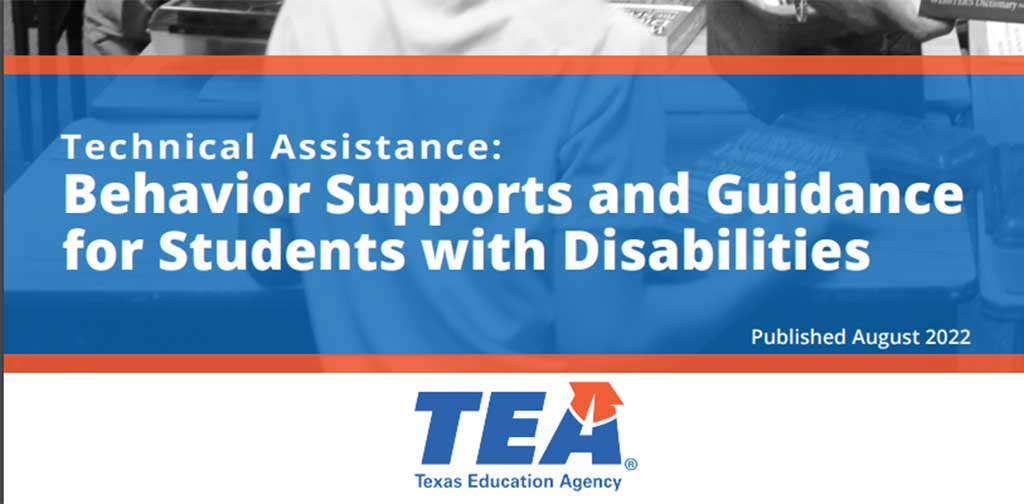The Texas legislature in the early 2000’s passed a law regarding the use of restraint and time-out in school districts. The Texas Education Agency (TEA) developed rules on procedures for when restraint can be used; training staff, and others; documentation, and notification on the use of restraint; situations that are not considered the use of restraint. Rules were also developed regarding procedures for when time-out can be used; training staff, and others; documentation on the use of time-out; and student safety. TAC §89.1053
Restraint
“Restraint means the use of physical force or a mechanical device to significantly restrict the free movement of all or a portion of the student’s body. A school employee, volunteer, or independent contractor may use restraint only in an emergency and with the following limitations.
(1) Restraint must be limited to the use of such reasonable force as is necessary to address the emergency.
(2) Restraint must be discontinued at the point at which the emergency no longer exists.
(3) Restraint must be implemented in such a way as to protect the health and safety of the student and others.
(4) Restraint must not deprive the student of basic human necessities.”
“Emergency means a situation in which a student’s behavior poses a threat of: (A) imminent, serious physical harm to the student or others; or (B) imminent, serious property destruction.”
A core team of personnel on each campus must be trained in the use of restraint, and must include a campus administrator or designee and any general or special education personnel likely to use restraint. Personnel called upon to use restraint in an emergency and who have not received prior training must receive training within 30 school days following the use of restraint. Training must include prevention and de-escalation techniques and provide alternatives to the use of restraint. Training must also include instruction in current professionally accepted practices and standards regarding behavior management and the use of restraint.
A number of companies have developed restraint training programs. School staff must be trained, and periodically retrained by staff from the company. The school certified person trains, and documents the training of school staff. Several state agencies have developed restraint training that public schools can utilize.
When restraint is used, school employees, volunteers, or independent contractors must: (1) On the day restraint is utilized, the campus administrator or designee must be notified verbally or in writing regarding the use of restraint. (2) On the day restraint is utilized, a good faith effort must be made to verbally notify the parent(s) regarding the use of restraint. (3) Written notification of the use of restraint must be placed in the mail or otherwise provided to the parent within one school day of the use of restraint. (4) Written documentation must be placed in the student’s special education eligibility folder in a timely manner so the information is available to the admission, review, and dismissal (ARD) committee when it considers the impact of the student’s behavior on the student’s learning and/or the creation or revision of a behavioral intervention plan (BIP).
Notification must include the name of the staff member(s) administering the restraint; date of the restraint and the time the restraint began and ended; location of the restraint; nature of the restraint; a description of the activity in which the student was engaged immediately preceding the use of restraint; the behavior that prompted the restraint; the efforts made to de-escalate the situation and alternatives to restraint that were attempted; and information documenting parent contact and notification.” It is not uncommon for some of these items to be left off of the form, or for nothing to be written for an item. Parents should request in writing to the principal, and special education office any required information that is not provided, or clearly understood.
These procedures do not apply to the use of physical force or a mechanical device that does not significantly restrict the free movement of all or a portion of the student’s body. Restraint that involves significant restriction does not include: physical contact or appropriately prescribed adaptive equipment to promote normative body positioning and/or physical functioning; limited physical contact with a student to promote safety (e.g., holding a student’s hand), prevent a potentially harmful action (e.g., running into the street), teach a skill, redirect attention, provide guidance to a location, or provide comfort; limited physical contact or appropriately prescribed adaptive equipment to prevent a student from engaging in ongoing, repetitive self-injurious behaviors, with that instruction being reflected in the individualized education program (IEP) to promote student learning and reduce and/or prevent the need for ongoing intervention; or seat belts and other safety equipment used to secure students during transportation.
Whether an emergency exists, what “reasonable force” is in a given situation, when the emergency stops, and what “serious property destruction” is are based on someone’s decision at that point in time. Formal and informal meetings before, and after restraints can be helpful in defining these terms and concepts for a specific student. Restraints are stressful to everyone involved.
Time-out
A school employee, volunteer, or independent contractor may use time-out with the following limitations.
(1) Physical force or threat of physical force must not be used when placing a student in time-out.
(2) “may only be used in conjunction with an array of positive behavior intervention strategies and techniques and must be included in the student’s IEP and/or BIP if it is utilized on a recurrent basis to increase or decrease a targeted behavior.”
(3) “must not be implemented in a fashion that precludes the ability of the student to be involved in and progress in the general curriculum and advance appropriately toward attaining the annual goals specified in the student’s IEP.”
General or special education personnel who implement time-out must be trained in the use of time-out. Newly-identified personnel called upon to implement time-out must receive training in the use of time-out within 30 school days of being assigned the responsibility for implementing time-out. “Training must be provided as part of a program which addresses a full continuum of positive behavioral intervention strategies, and must address the impact of time-out on the ability of the student to be involved in and progress in the general curriculum and advance appropriately toward attaining the annual goals specified in the student’s IEP.” All trained personnel must receive instruction in current professionally accepted practices and standards regarding behavior management and the use of time-out.
“Necessary documentation or data collection regarding the use of time-out, if any, must be addressed in the IEP or BIP. The ARD committee must use any collected data to judge the effectiveness of the intervention and provide a basis for making determinations regarding its continued use.” Since schools are not required to document the use of time-out or collect data, it is important that parents request, and push the ARD/IEP team to have the use documented, and communicated to them, and the team. Parents can obtain information in some cases from their child, or cameras that might be located in the classroom.
“Any behavior management technique and/or discipline management practice must be implemented in such a way as to protect the health and safety of the student and others. No discipline management practice may be calculated to inflict injury, cause harm, demean, or deprive the student of basic human necessities.”
Data regarding the use of restraint must be electronically reported to TEA
Parents should obtain, and review district policy, and procedures regarding restraint, and time-out. They should insist that the IEP or BIP include a variety of positive behavior intervention strategies and techniques. If the child’s behavior is not improving, the use of these should be reviewed. As needed they should request informal, and ARD/IEP meetings to review and revise the IEP, or BIP. If a school refuses a written request for an ARD meeting, they must reply with a written notice of refusal.



